 |
Ethan Perry,
Plant Ecologist/
Botanist |
September 11:
"A crack team convened at the Lake Leander site of the endangered plant, Western Jacob's ladder (Polemonium occidentale
spp. lacustre
), east of McCarthy Beach State Park, one of only 4 known populations in Minnesota. Reporting for duty were MBS plant ecologists Chel Anderson, Rebecca Holmstrom, Jeff Lee, and some other guy. Our mission: to re-find the population 20 years after Chel had sampled it with a transect across the open conifer swamp.Earlier in the year Rebecca and Jeff had passed through the area without seeing any. Imagine our dismay when the four of us spread out in a line and crossed the swamp, again seeing no sign of Polemonium
. But we did not despair. If it's out there, these 4 pairs of eyes can surely find it. On our next pass, we found a small patch! Later we came across another larger patch. None of the plants had flowering stalks. Strange-looking stakes were stuck in the moss, left from a past study. Quite a novel use of a lawn chair! Chel claims no knowledge of it.The Polemonium
lives on, but Chel's impression is that the population has diminished considerably. Shortly before it was discovered in 1991 much of the black spruce and cedar was logged out of part of the swamp. Initially, the plants appeared to respond with increased flowering. Our difficulty finding them now suggests the long term effect may be less beneficial, but any conclusion would require a more complete inventory.Afterwards, we hiked to nearby beaver ponds and expanded the known extent of another endangered plant, Floating marsh-marigold (Caltha natans
), that Rebecca and Jeff had found earlier. One pond also contains the threatened Small white water-lily (Nymphaea leibergii
), an unusual habitat for this species."
 |
Daniel Wovcha,
Plant Ecologist |
Late-August:
"MBS plant ecologists Mike Lee, Jeff Lee, Norm Aaseng, and I spent 8 days in mid-August doing native plant community and rare plant surveys around the Pipestone, Back, and Jackfish Bay areas of Basswood Lake in the Boundary Waters Canoe Area Wilderness (BWCA)."
 |
Jeff Lee,
Plant
Ecologist/
Botanist |
July 25-31. "
On a recent trip to the Boundary Waters Canoe Area Wilderness, fellow plant ecologist/botanist Chel Anderson and I set out from Sea Gull Lake towards several lakes to the southwest. Over seven days, we focused much of our surveying efforts on the magnificent bedrock cliffs (CTn11a, CTn11b, CTn11d) along Wisini and Kekekabic Lakes and woodland and forest communities impacted and unaffected by the extensive blowdown of 1999. Additionally, we wanted to survey a large fen complex, document a high-quality wet forest community and evaluate the floristic response of fire dependent communities to the wildfires and prescribed burns that have occurred recently and as far back as 1976 for one wildfire. We were pleased to discover that after these severe disturbances, the early-successional flora appeared to be doing fine. Many groundcover species representative of a pre-disturbance state were present along with those that colonize quickly after disturbances, such as red raspberry (Rubus idaeus
) and fringed black-bindweed (Fallopia cilinodis
). Shrub cover was often dense, but (depending on the community) noticeable regeneration and recruitment of white pine, jack pine, white cedar and red pine was underway. Botanically, we revisited known populations of twig rush (Cladium mariscoides
, special concern) and maidenhair spleenwort (Asplenium trichomanes
, threatened). Both populations, though limited, were unchanged from previous years, the latter well-protected cozied up in a rock crevice overhang. Perhaps most exciting for me was my first bouldering experience along steep-sided cliffs and traversing talus slopes to obtain better views of cliff communities. From the canoe, it seemed a daunting task, but our reward was documenting a new population of a tracked species, Oregon woodsia (Woodsia oregana). The more common rusty woodsia (Woodsia ilvensis
) was readily seen in many locations and microhabitats, but Oregon woodsia was found on only one of the cliff features we searched, in shaded and protected microhabitats unlike other populations found thus far in the Border Lakes Subsection. The remoteness of these cliff sites made our work an adventure. With multiple portages, long stretches of water to cross, and unsure footing during rock scrambles, the effort required to find rare plants almost seemed Herculean. Therefore, in honor of the London Olympics, I propose a new event be initiated: the "padding-portaging-rock scaling-botanical collection” event. I'm sure MBS staff would represent our country well! "
 |
Courtney Kerns,
Plant
Ecologist/
Botanist |
July 17-24. "
Fellow botanist/plant ecologist Mike Lee and I entered the Boundary Waters Canoe Area Wilderness on July 17th for a week of surveys in the Wind Lake area. On our first field day we hiked through dense upland forest regenerating from the July 4, 1999 windstorm and across hummocky Sphagnum to a small, remote bog lake named Acorn Lake. As with many out-of-the-way spots in the Boundary Waters, it was interesting to ponder just how many people had ever been there, and why. We found blooming club-spur orchids (Platanthera clavellata
) growing in richer parts of the conifer swamp surrounding the lake. In the following days we collected species data in vegetation plots (releves) with an emphasis on native plant communities that are uncommon or poorly documented in the Border Lakes ECS Subsection, such as Northern Rich Tamarack Swamp, Northern Shrub Shore Fen, Northern Wet Ash Swamp, and Northern Cedar Swamp. Extensive moose trails crisscrossed most of the Sphagnum-dominated areas that we traversed, and we recorded several new locations for Splachnum sp. mosses on piles of moose dung. Mike noted that it was encouraging to see a bit of moose sign this year (recent dung, active trails, recent browse), as he had seen very little in nearby parts of northern Lake County in 2011. However, the amount of moose sign, including dung moss records, was down significantly from what Mike and other MBS field ecologists noted in Cook County in 2009 and 2010. Sandy and gravelly stretches of shoreline were surveyed for aquatic plants and collections were made; American shoreweed (Littorella uniflora
var. americana
) and slender water-milfoil (Myriophyllum tenellum
) were highlights from a day spent on Wind Lake and Wind Bay of Basswood Lake. Notable for northern Lake County was a large population of northern adder's tongue fern (Ophioglossum pusillum
) along the margins of an old beaver meadow.Memorable bird and mammal experiences were interspersed throughout the trip: raucous, squalling mystery mammals that ran a complete circle around my tent one night before banging into and off of the stowed canoe; the toad and mouse who joined us under the tarp during the thunderstorm as we tried to keep the plant press dry; a Common Loon that decided to follow the canoe and have its portrait taken on Washte Lake; a Whip-poor-will calling from across the lake, and a Bald Eagle who graced our exit paddle off Wind Lake with a spectacular, close-range fish capture.As is typical, we made contact with several BWCAW visitors and familiarized them with MBS' work. They're often surprised at the amount of gear we need, and that we don't spend any of our days relaxing and recreating. However, as one of them said, "You sure have a nice office." We couldn't agree more! "
 |
Lynden Gerdes,
Botanist |
 |
Lawson Gerdes,
Northern
Coordinator/ Plant Ecologist/Botanist |
July 10 - 17.
"One focus of our fieldwork recently conducted in the Bald Eagle Lake area of the BWCAW was to relocate a population of small white water lily (Nymphaea leibergii
). This lily was first documented in Minnesota from the shallow water of Bald Eagle Lake by Ned L. Huff in 1914. Although additional locations have been found in the state since that time, the Bald Eagle population had gone undetected for the past 98 years. During our trip, we documented two populations of small white water lilies approximately 2.5 miles distant from each other. One population was from the mouth of a shallow stream, the other from a small isolated fen pond. Although we encountered several other areas in the lake that appeared to have the quite distinctive leaves of N. leibergii
, we were not able to find flowers or fruit associated with these plants that are necessary to confirm identification.Why did it take 98 years to relocate the small white water lily in this watershed? Although there have been other searches to find this species in Bald Eagle Lake....water levels, phenology, survey conditions, possible population fluctuations, etc. all effect survey outcomes. We were fortunate to time our survey while the plants were in flower and happened to catch a year having conditions conducive to producing nice numbers of plants. The fact that this population is still flourishing in the same waters (August Creek basin) of the Rainy River Watershed as it did nearly 100 years ago supports the imperative to protect the high quality aquatic communities and overall biodiversity of this watershed for future generations. May someone in the distant future paddling in the Bald Eagle Lake area also experience the beauty of the small white water lily?Another exciting observation made on our trip was that of Franklin's Phacelia (Phacelia franklinii
). Two populations were observed near shore in association with jack pine tip ups. When jack pine is blown over in shallow mineral soils (often over bedrock in the Border Lakes subsection, the raised root wad freshly exposes sand/gravel/cobble soils. It is suspected that Phacelia maintains its seed viability in the soil bank for many years, so that when a tree tosses, the tiny, black seeds (dormant in the soil for many years) germinate, flower and bank more seed. The species might then flourish for several years, producing and shedding hundreds (likely more) of seeds until the local population is once again outcompeted by other plant species. Many of the historic populations of Phacelia franklinii
in MN have not been relocated and this process may be part of the story. These cycles and disturbance regimes need be given the time, space and opportunity to repeat themselves on the landscape. Native plant communities need also be conserved in the highest quality to help ensure these species and their seed banks have the potential to persist over time. We also surveyed an expansive Graminoid Rich Fen, northeast of Bald Eagle Lake. The fen, also in the August Creek basin, supports populations of Michaux's sedge (Carex michauxiana
), Club-spur orchid (Platanthera clavellata
), Sooty-colored beak-rush (Rhynchospora fusca
), and Montane yellow-eyed grass (Xyris montana
)."
 |
Derek Anderson,
Plant Ecologist/
Botanist |
June 27 - July 10. MBS staff and volunteers completed the annual monitoring of the
Western prairie fringed orchid across the state of Minnesota. During the first week, effort was focused in southern Minnesota, where drought conditions were less severe than elsewhere and plants were in better shape than their northern counterparts. However, they were starting to show signs of dessication as drought continued to persist in the southwest. Into July, monitoring effort was focused in northwestern Minnesota. In this part of the state plants were impacted by a number of stresses, including a late season frost in addition to drought.
 |
Jeff Lee,
Plant
Ecologist/
Botanist |
June 29-July 7. "
On my very first weeklong canoe, camp, and plant survey outing, MBS plant ecologist/botanist Mike Lee and I began our trip at the Hubachek Wilderness Research Center on Fall Lake, where we paddled across to the historic Four Mile Portage en route to our campsite nearly two miles down the trail to Ella Hall Lake. Leaving from our basecamp each morning, we paddled, portaged, and hiked cross-country to our destinations around Slumber, Muskeg, Mud, and Ella Hall Lakes.In my new role with MBS as a plant ecologist/botanist, I was assisting Mike and beginning to familiarize myself with northeastern Minnesota's native plant communities, flora, and MBS survey techniques. We witnessed flowering of several orchids: Calopogon tuberosus, Pogonia ophioglossoides, Platanthera dilatata, Platanthera huronensis, Platanthera lacera, Listera cordata, Corallorhiza trifida,
and Corallorhiza maculata
. Additionally, I learned several common species of aquatic plants, numerous graminoids, and mosses. Northern Mesic Mixed Forests, Northern Spruce Bogs and Poor Conifer Swamps, Northern Poor Fens, Northern Rich Fens, Northern Shrub Shore Fens, Northern Cedar Swamps, and Northern Black Ash Swamps were just a handful of communities we surveyed. Highlights included extensive rich and poor fens surrounding Slumber Lake, Black Spruce Bogs along Muskeg Creek, Cedar Swamps south of Mud Lake, and Ash Swamps north of Ella Hall Lake, and rich shrub fens on Muskeg Lake. Mike made numerous plant collections bound for the Bell Museum with notable ones being Xyris montana,
Ranunculus lapponicus,
Rhynchospora fusca,
and several locations for a specialized moss growing on moose dung, likely Splachnum ampullaceum
.Working in the remoteness of the BWCWA was its own reward and seeing my first moose and wolf made this inaugural trip an unforgettable one for me. Mike tells me the moose, and good amount of moose sign, was notable for the areas he's worked in Lake County the past two years. Temperatures in the 90s, high humidity, pesky biting insects, and a severe thunderstorm that drove rain under our work tarp and dampened Mike's plant press made the botanical and ecological discoveries all the more rewarding.We also stopped for a few hours on our way back to Duluth at a small spring fen near Finland to learn some additional plants and the rare plant community they occur in. Here we documented new records of Drosera linearis and Utricularia geminiscapa
, which were in addition to the populations of Drosera anglica, Rhynchospora fusca,
Juncus stygius,
and Carex exilis that Mike recorded there in 2000."
 |
Lawson Gerdes,
Northern Coordinator/
Plant Ecologist/Botanist |
July 6. "
With the first portage behind us and our canoe loaded with field gear, we were committed. So...on day two of a deluge of historic proportions in Northeastern Minnesota, new MBS staff plant ecologist/botanist Courtney Kerns and I await a break in one of the many, strong and rapidly moving squalls before shoving off into the Kawishiwi River. The objective of our trip was to collect information to help assess the biodiversity significance of the Kawishiwi River area relative to other areas in the Border Lakes subsection and the state as a whole. Although disturbance history data indicated stand-replacing fires across the area in the mid-late 1800s and documented that some areas were partially cutover by the St. Croix lumber company in the early 1900s, old, high quality upland forests and woodlands were evident in small patches throughout and super-canopy pine and spruce occurred regularly in the aspen-birch-balsam fir dominated forest matrix. Survey data included sampling high-quality examples of White Pine-Red Pine Forest (FDn43a), Rich Black Spruce Swamp (FPn62a), White Pine-Red Pine Woodland (FDn32a). Suitable aquatic and terrestrial habitats were searched for rare plant species such as Thalictrum revolutum,
Pyrola minor,
Littorella uniflora var. americana, Myriophyllum tenellum,
Subularia aquatica var. americana,
Luzula parviflora, Geocaulon lividum
and Carex praticola.
Surveys also included searches for species that are suspected to occur but are not yet documented from the central or northern portions of the county, such as Nuphar rubrodisca
, and the documentation of invasive species locations. A number of plant collections were made for species verification and documentation.These data not only inform MBS assessment of the biodiversity significance of the area, they also contribute to efforts such as the Kawishiwi Watershed protection project, a 3-year water quality assessment project within the 750,000 acre watershed area. The project is jointly supported Lake County, MPCA and the White Iron Chain of Lakes Association. The other objective of the trip was to provide training in field work planning and field skills development. Below are Courtney Kerns' impressions as a new plant ecologist/botanist with MBS:"  |
Courtney Kerns,
Plant
Ecologist/
Botanist |
"This was my first overnight wilderness trip. As the days went by, I realized I had never before been immersed in a truly continuous natural landscape. No roads, no ditches, no power line rights-of-way, no abrupt human-made transitions of any kind were visible. Forest, woodland, and wetland natural communities transitioned seamlessly into one another. Lakes, rivers, and streams were our highways and back roads.Our tents provided a modicum of privacy and protection from the elements, but otherwise we shared all our living and working activities with myriad other species: morning coffee with warblers, mergansers, and the occasional wolf howl; the daily canoe "commute" with dragonflies, loons and goldeneyes; data collection under pines and spruces on luxurious carpets of mosses and lichens…and all of the above with persistent mosquitos until some merciful winds blew in the last couple of days. What a stark and valuable contrast to the world most of us spend the vast majority of our days in!"
 |
Fred Harris,
Plant Ecologist/
Botanist |
June 27. "
In Kittson County this June, thousands of showy lady's- slippers (Cypripedium reginae)
flowered in roadside ditches. It was the talk of the town in Karlstad.
 |
Janeen Ruby,
Plant Ecologist |
June 27. "
I visited a wet prairie/wet meadow in Jackson County to document plant species with no known herbarium voucher from the county. Many plant species were in bloom, including two native lily species The wet meadow was full of textures and colors, from wide-leaved cattail, to green bulrush, to leaves from water hemlock. The wet meadow was full of textures and colors, from wide-leaved cattail, to green bulrush, to leaves from water hemlock. |
 Water hemlock (Cicuta maculata) in bloom. Water hemlock (Cicuta maculata) in bloom. |
 Michigan lily (Lilium michiganense). Michigan lily (Lilium michiganense). |
 Canada tick trefoil (Desmodium canadense) sets a purple background for bright yellow oxeye sunflower (Heliopsis helianthoides). The stiff leaves of Cordgrass arch through the photo. Canada tick trefoil (Desmodium canadense) sets a purple background for bright yellow oxeye sunflower (Heliopsis helianthoides). The stiff leaves of Cordgrass arch through the photo. |
 The lovely prairie lily (Lilium philadelphicum) in bloom. The lovely prairie lily (Lilium philadelphicum) in bloom. |
 |
Fred Harris,
Plant Ecologist/
Botansit |
June 20. "
While testing monitoring techniques at Kasota Prairie SNA we viewed a spectacular bloom of Butterfly weed (Asclepias tuberosa
). A prescribed fire burned this site in the spring 2012". |
 "I found several crab spiders concealed beneath the flowers. One spider had successfully ambushed a bee". "I found several crab spiders concealed beneath the flowers. One spider had successfully ambushed a bee". |
 |
Derek Anderson,
Plant Ecologist/
Botanist |
May:
Small white lady's-slippers (
Cypripedium candidum) are a small prairie orchid found throughout the prairie region of Minnesota. This species is found in higher quality prairies, and was chosen as one of two indicator plants that would measure success in the
Minnesota Prairie Conservation Plan 2010 . With funding from
Minnesota's Environment and Natural Resources Trust Fund, MBS staff field tested monitoring protocols and collected baseline data with the help of 12 volunteers who donated over 100 hours of time. An effort was made to relocate and map the boundaries of populations at 15 sites. There were some sites that had not been formally revisited in over 30 years.
 |
Carol Hall,
Herpetologist |
Late May.
"Four-toed Salamanders were documented in southern St. Louis County during searches in late-May. At one site over 20 eggs were found in a mound of sphagnum located in a shallow forest wetland. Upon hatching, the larvae travel through the sphagnum into adjacent water. There they will feed on tiny invertebrates and emerge in July or August when they transform into their terrestrial phase and move to upland forest habitat.At a second site, a female was found nest-guarding a cluster of approximately 27 eggs. A female salamander often remains with the egg cluster until hatching, moving throughout the cluster transferring anti-microbial skin secretions to the eggs. This female is in the early phase of growing a new tail. Four-toed Salamanders can detach their tail when threatened by a predator. During dormant periods their tail serves as a nutrient source, individuals that start winter dormancy without a tail may be at a disadvantage."
 |
Ethan Perry,
Plant Ecologist/
Botanist |
May 23:
"Rebecca Holmstrom, Courtney Kerns, and I joined DNR Regional Plant Ecologist Bruce Carlson and staff from the St. Louis County Land Dept for a damp meeting at a northern hardwood forest on County land in the Toimi Uplands Subsection north of Duluth. This forest, which MBS had not visited during earlier field surveys, first caught my attention when I was mapping native plant communities. It is dominated by sugar maple, but air photos show a significant component of white cedar, which suggested it might be an example of White Cedar—Yellow Birch Forest (MHn45b), which is a type within the Northern Mesic Hardwood (Cedar) Forest (MHn45) native plant community class. This is a rare plant community type at both the state and continental scale.We confirmed the presence of MHn45b, and assessed its quality as varying from B to AB rank. Scattered throughout the forest we also found triangle moonwort (Botrychium lanceolatum var. angustisegmentum) ferns, which are listed as a Threatened species in Minnesota. Many were in a part of the forest where the County has planned a timber sale, and we discussed with the County possible methods of selective timber harvest that should not harm the moonwort. They are considering conservation options for another part of the forest with the oldest trees and the highest concentration of cedar".  Courtney Kerns gets acquainted with triangle moonwort. Can you see it? There is just one plant in the photo, along with one matricary moonwort. Courtney Kerns gets acquainted with triangle moonwort. Can you see it? There is just one plant in the photo, along with one matricary moonwort. |

Matricary moonwort (left) triangle moonwort (right) |
 Jason Meyer of the St. Louis County Land Department discusses the significance of this hardwood forest with Bruce Carlson, Courtney Kerns, and Rebecca Holmstrom. Jason Meyer of the St. Louis County Land Department discusses the significance of this hardwood forest with Bruce Carlson, Courtney Kerns, and Rebecca Holmstrom. |
 |
Jeff LeClere,
Zoologist |
May 17: "
Prescribed fire is a useful tool for prairie management, and essential for some prairie species such as this plains hog-nosed snake (Heterodon nasicus
). It is listed as a Species of Special Concern in Minnesota. I found this beauty in an earthen depression effectively taking cover from a prairie burn in western Minnesota".
 |
Jeff LeClere,
Zoologist |
Early May:
Rat snakes (
Elaphe obsoleta) are one of Minnesota's rarest snake species. They are listed as a species of Special Concern in Minnesota. Like many amphibians and reptiles, they emerged from winter dormancy earlier than usual this spring due to the unseasonably warm weather.
 |
Derek Anderson,
Plant Ecologist/
Botanist |
Early April: Nerstrand Big Woods State Park Monitoring.
The warm weather of March meant an early spring for the ephemeral wildflowers of the forest. This included the Minnesota dwarf trout lily (Erythronium propullans). Our monitoring work of this species needed to be completed three to four weeks earlier than past years. Nineteen volunteers donated nearly 150 hours to assist with the annual monitoring of this species.
 Minnesota dwarf trout lily (Erythronium propullans). Photo by volunteer Don Kaddatz. Minnesota dwarf trout lily (Erythronium propullans). Photo by volunteer Don Kaddatz. |
 Derek Anderson works with a volunteer to flag and count flowering individuals at Nerstrand Big Woods State Park. Photo by volunteer Ron Taallerud. Derek Anderson works with a volunteer to flag and count flowering individuals at Nerstrand Big Woods State Park. Photo by volunteer Ron Taallerud. |
 Volunteers flag individual flowering plants. Photo Ron Taallerud. Volunteers flag individual flowering plants. Photo Ron Taallerud. |


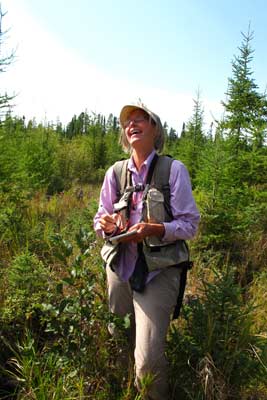
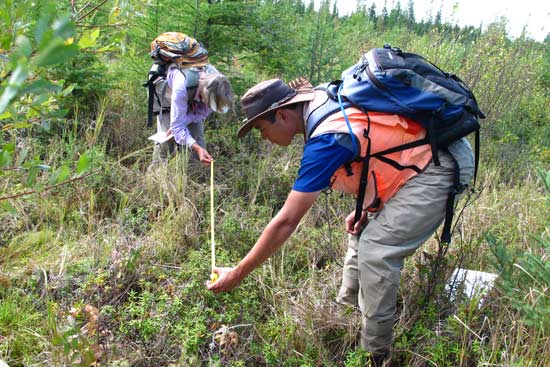
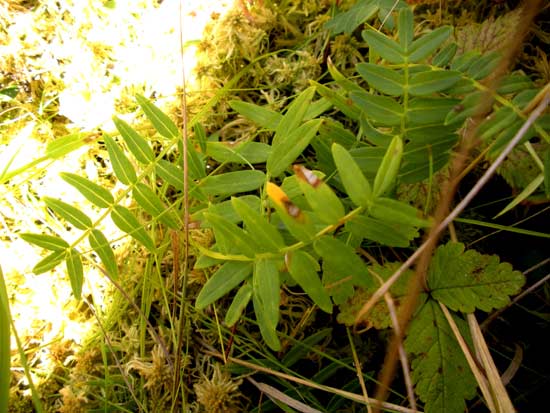

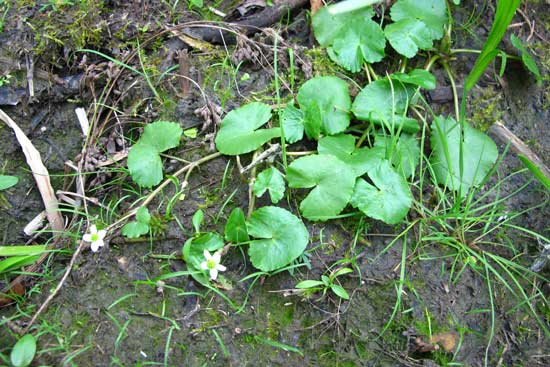
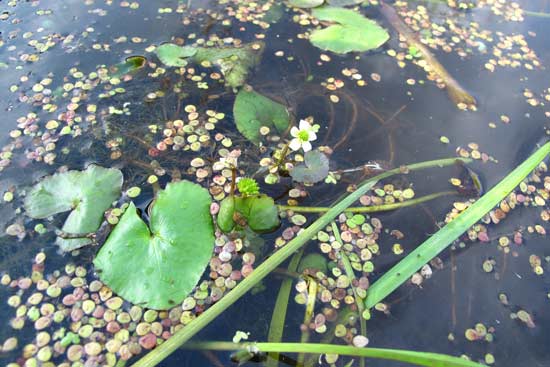


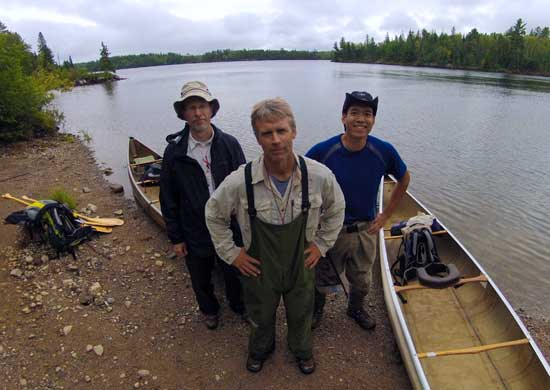
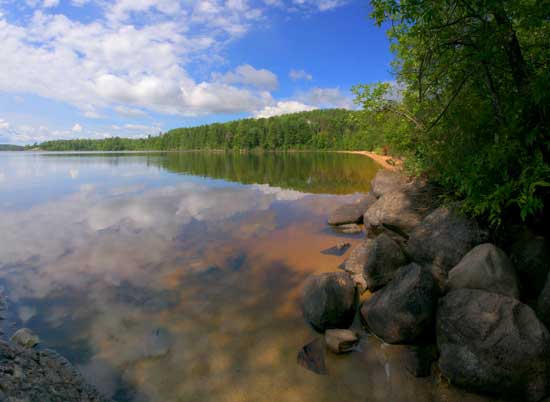
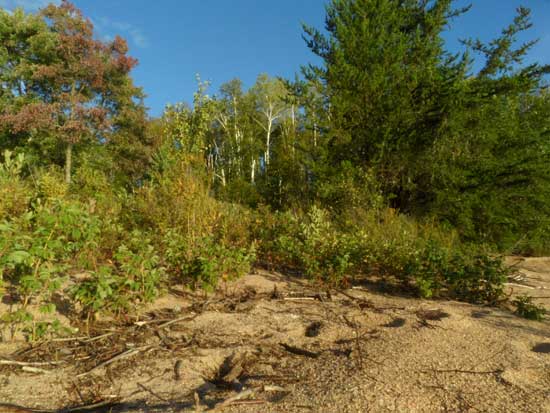
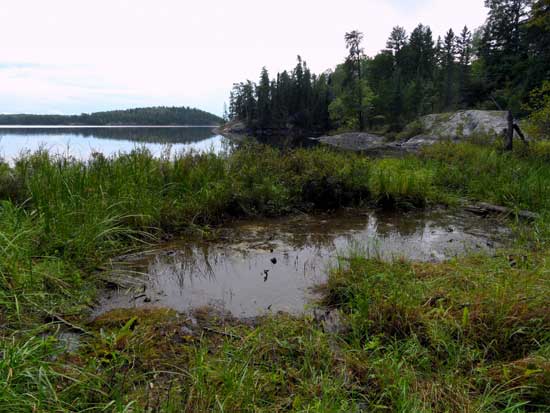
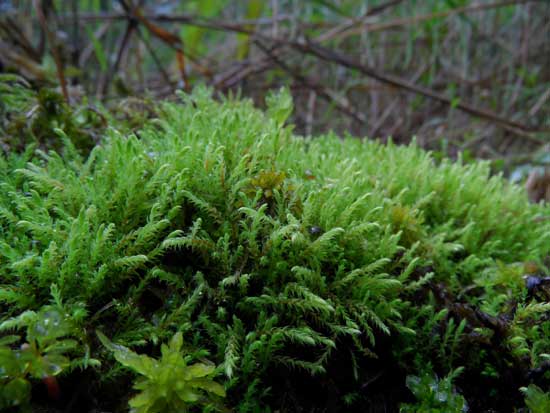
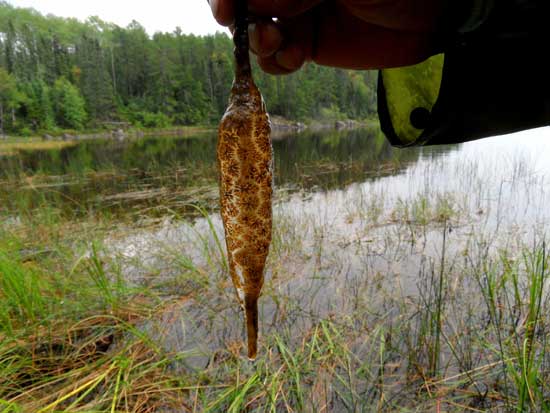

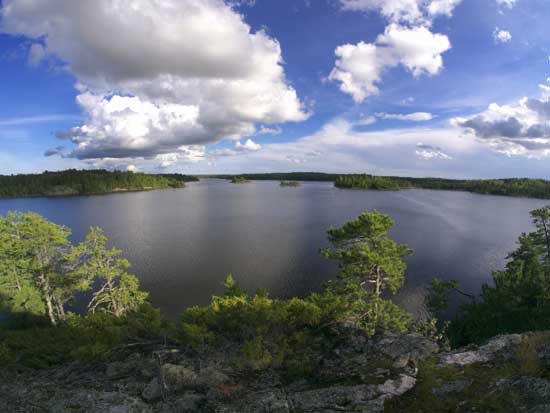











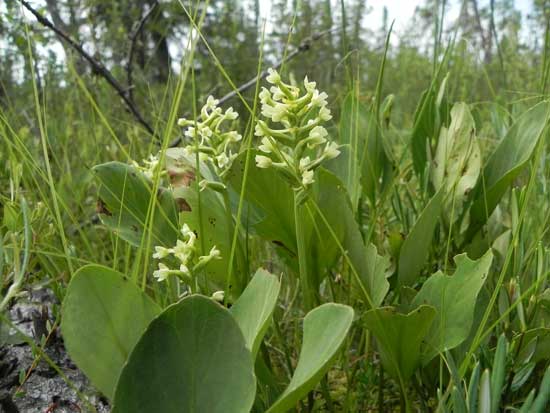
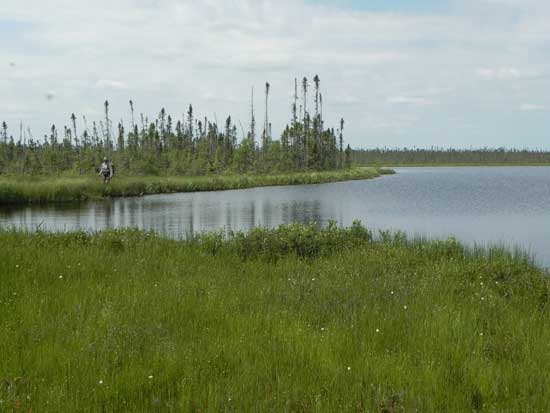
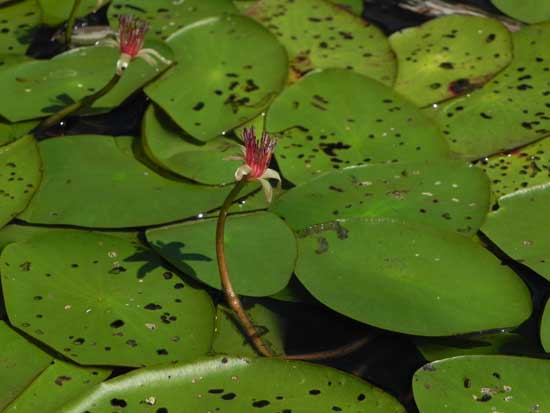
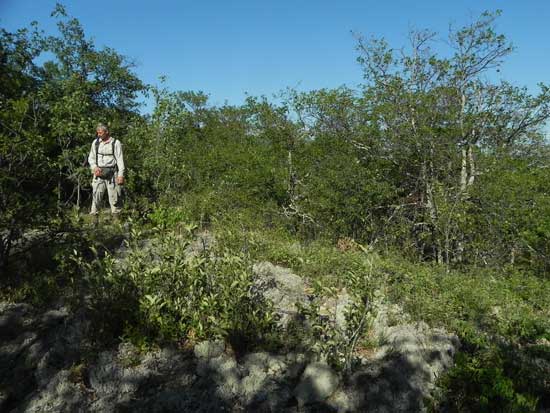

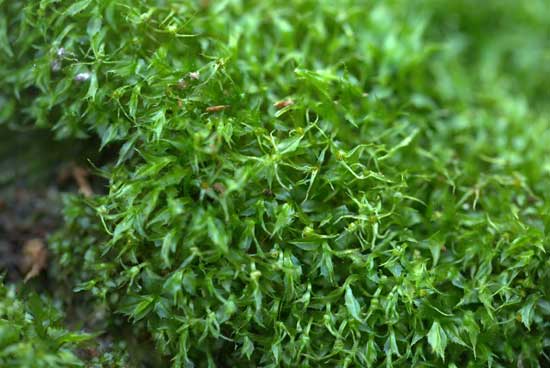
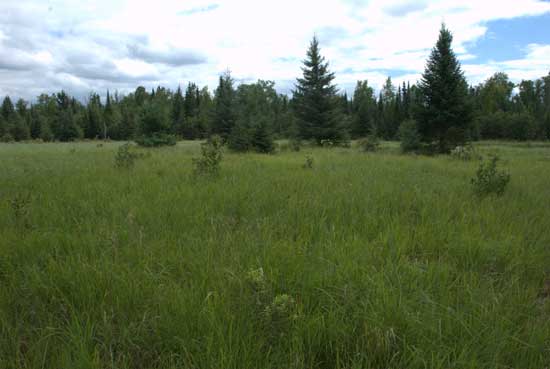
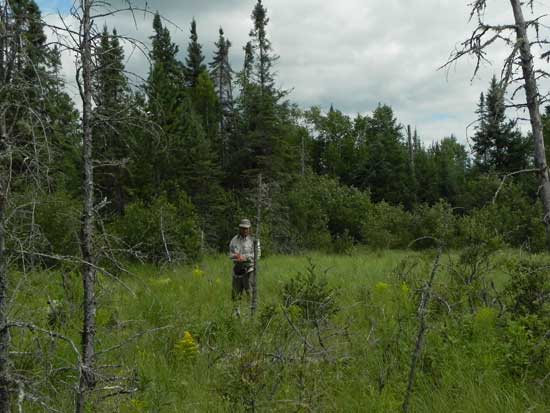

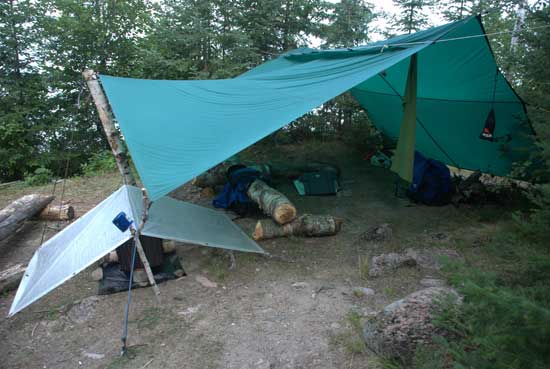
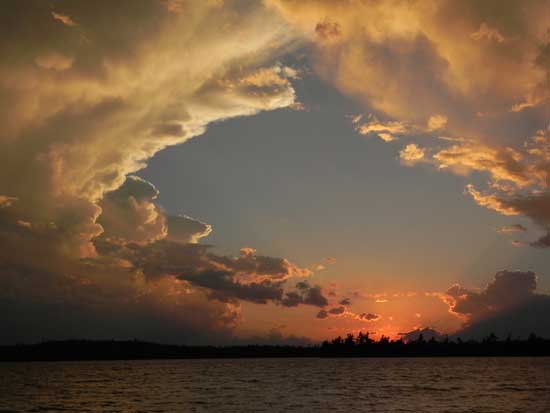



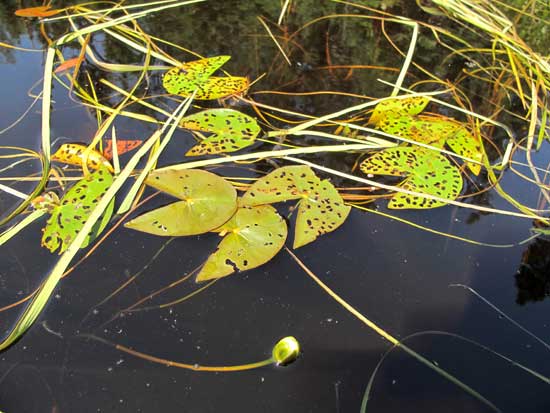
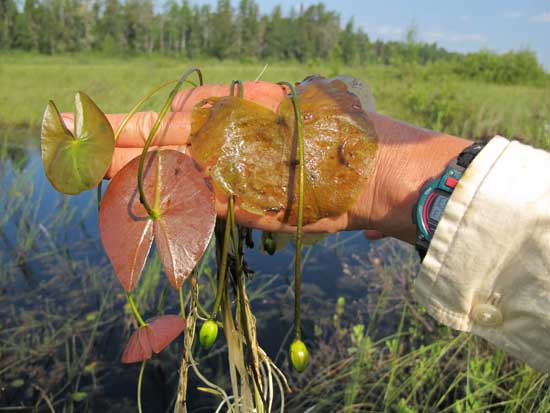


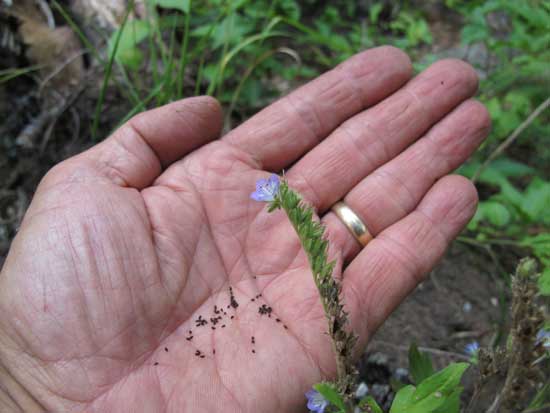
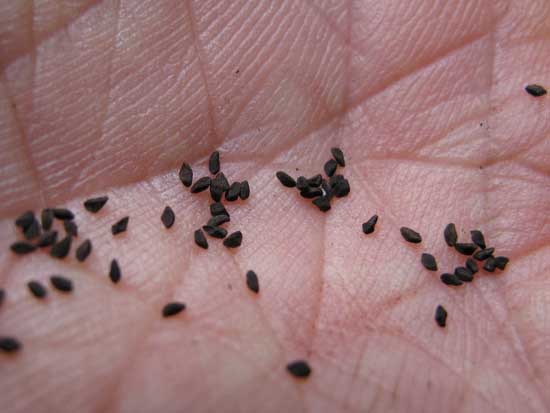
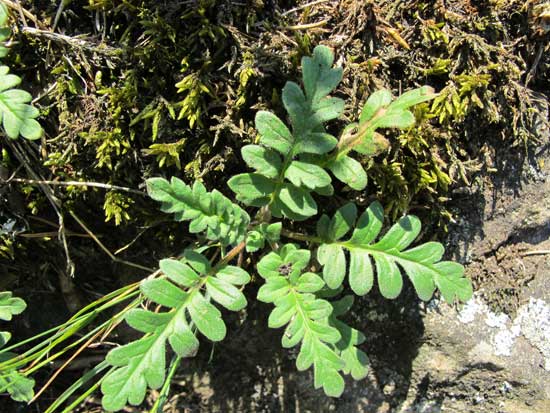
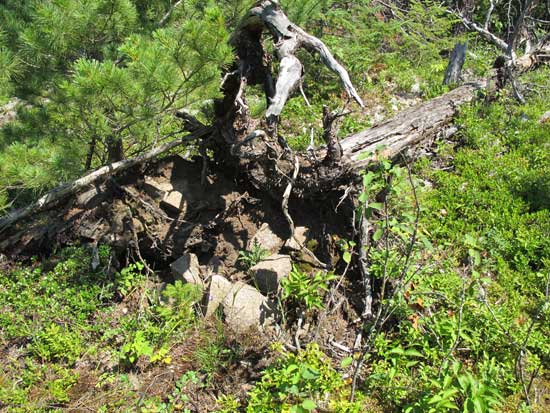

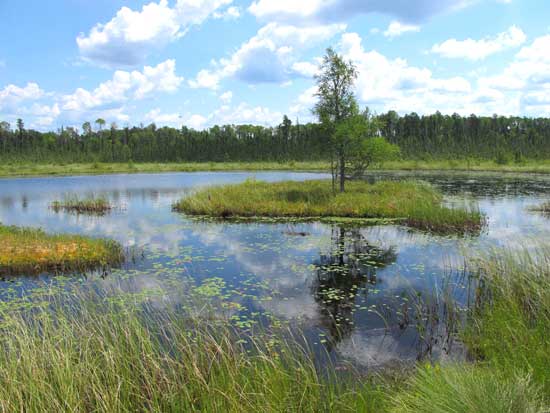


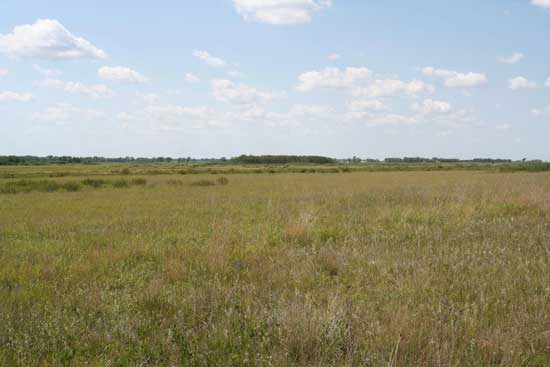
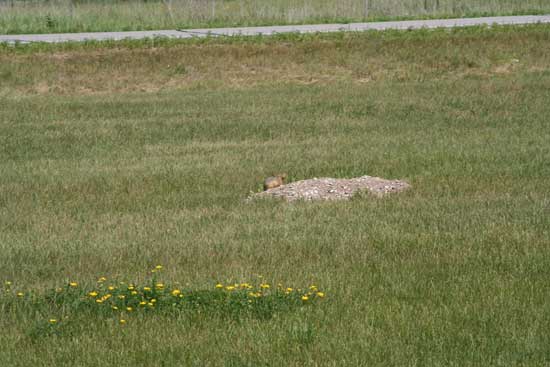
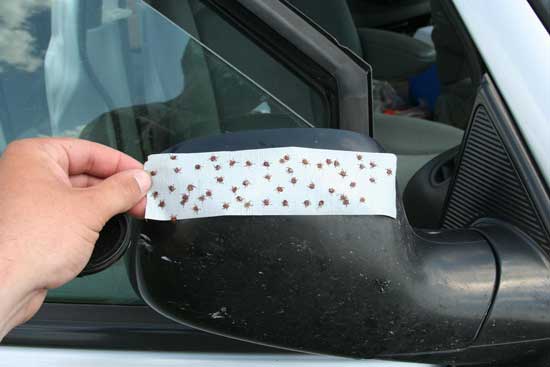
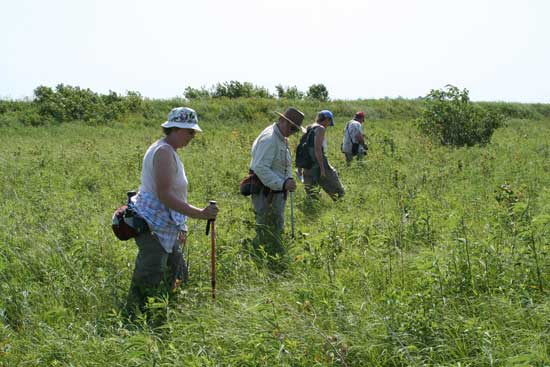
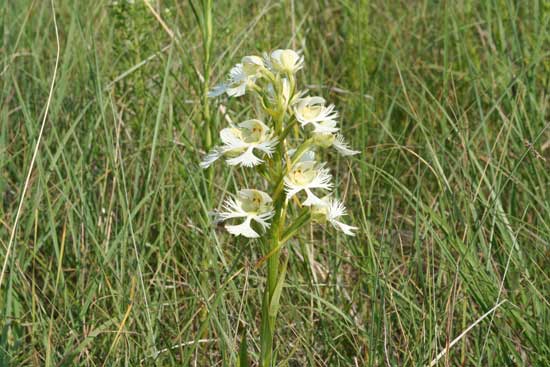
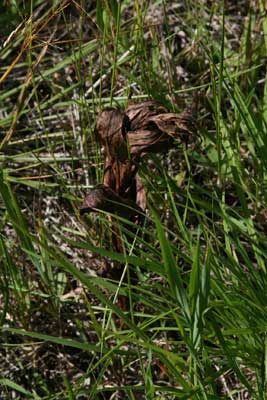


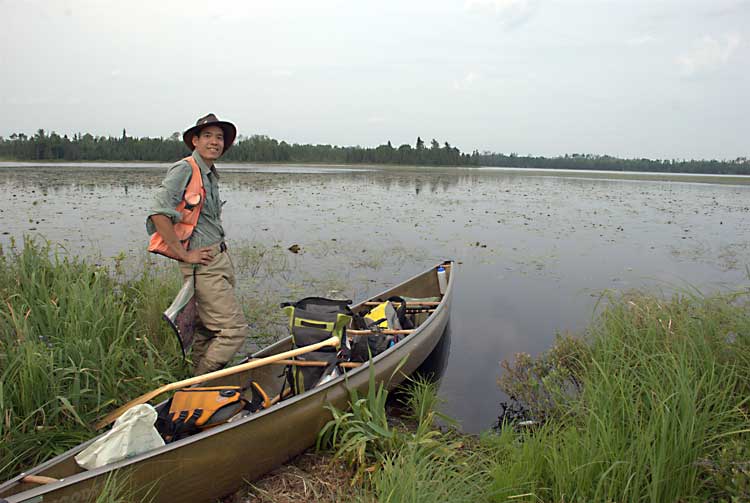
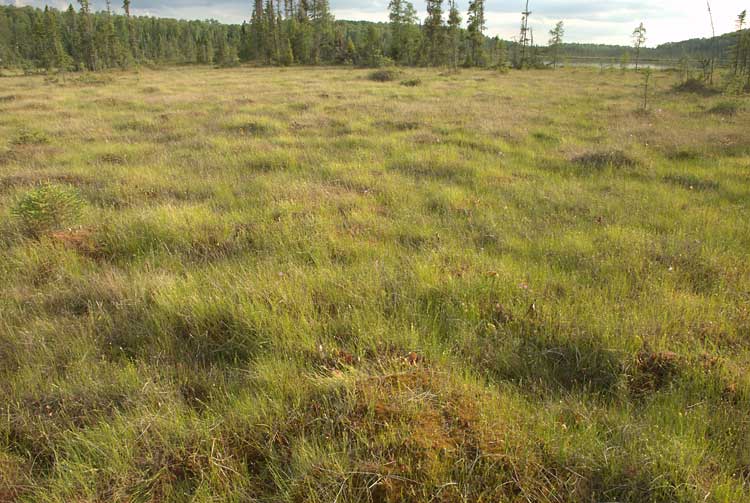
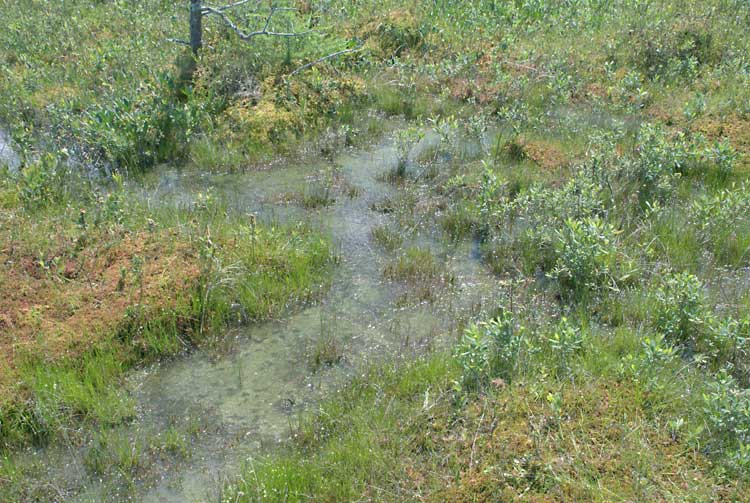
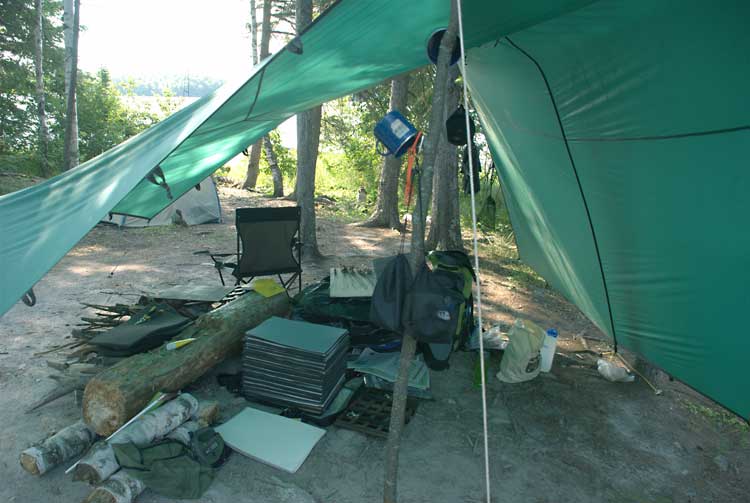
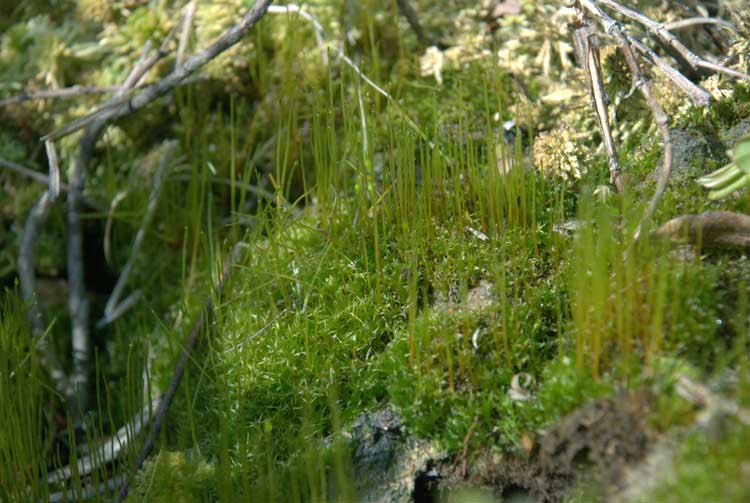
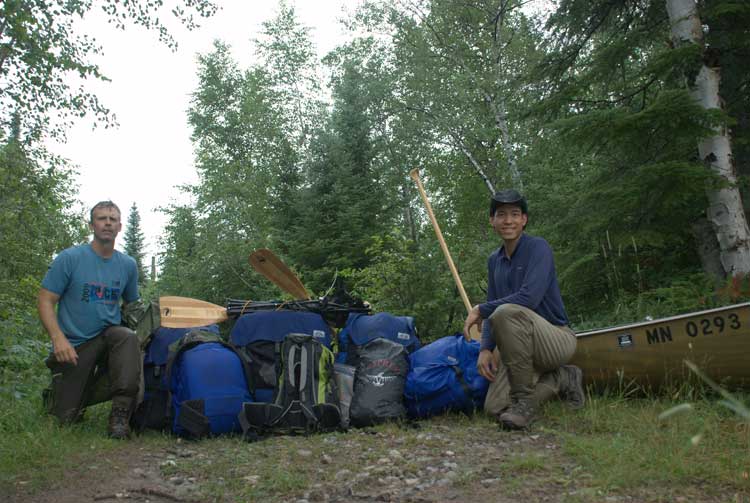






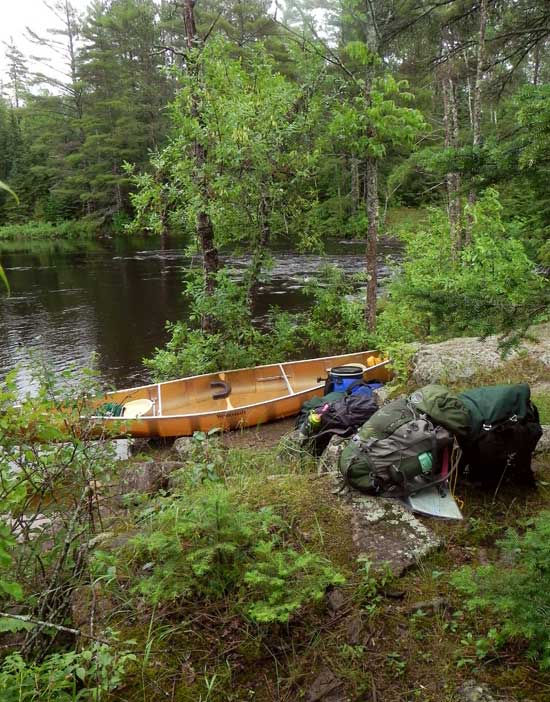
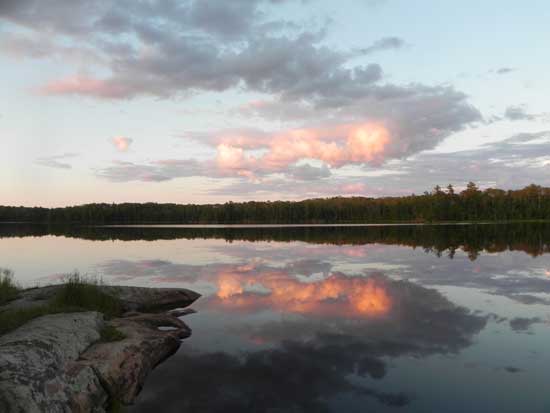
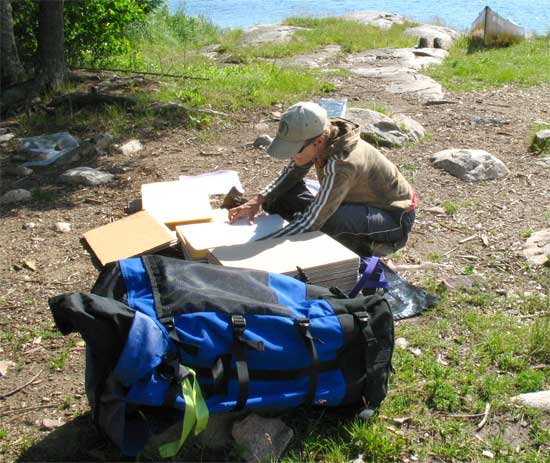
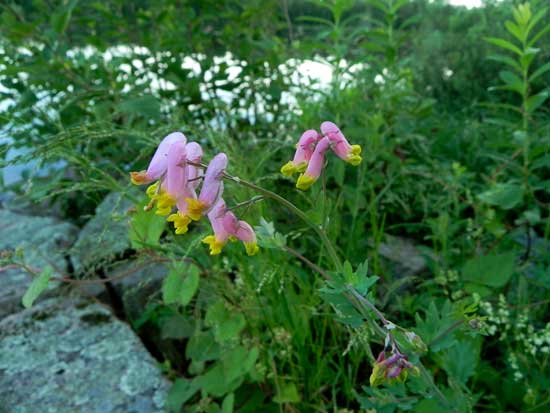
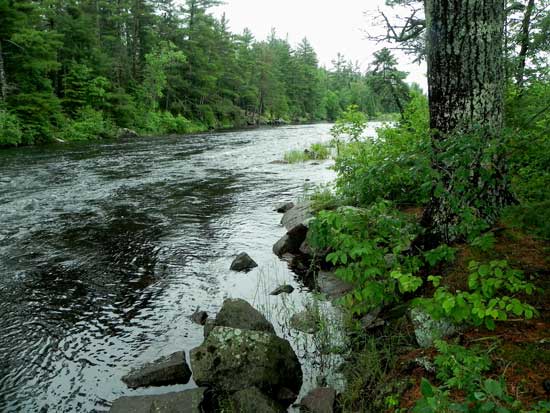






 The wet meadow was full of textures and colors, from wide-leaved cattail, to green bulrush, to leaves from water hemlock.
The wet meadow was full of textures and colors, from wide-leaved cattail, to green bulrush, to leaves from water hemlock. Water hemlock (Cicuta maculata) in bloom.
Water hemlock (Cicuta maculata) in bloom. Michigan lily (Lilium michiganense).
Michigan lily (Lilium michiganense). Canada tick trefoil (Desmodium canadense) sets a purple background for bright yellow oxeye sunflower (Heliopsis helianthoides). The stiff leaves of Cordgrass arch through the photo.
Canada tick trefoil (Desmodium canadense) sets a purple background for bright yellow oxeye sunflower (Heliopsis helianthoides). The stiff leaves of Cordgrass arch through the photo. The lovely prairie lily (Lilium philadelphicum) in bloom.
The lovely prairie lily (Lilium philadelphicum) in bloom.


 "I found several crab spiders concealed beneath the flowers. One spider had successfully ambushed a bee".
"I found several crab spiders concealed beneath the flowers. One spider had successfully ambushed a bee".








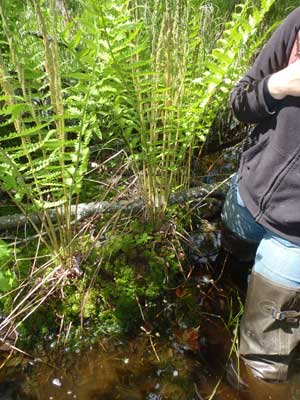
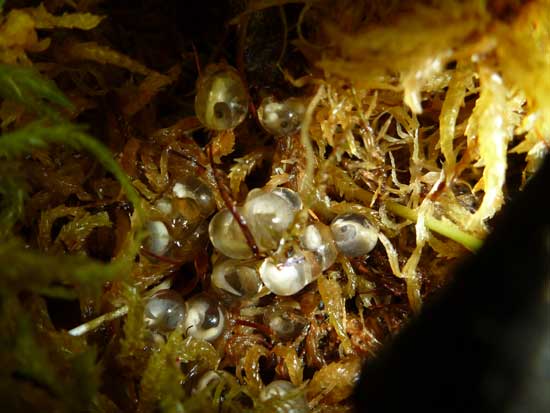
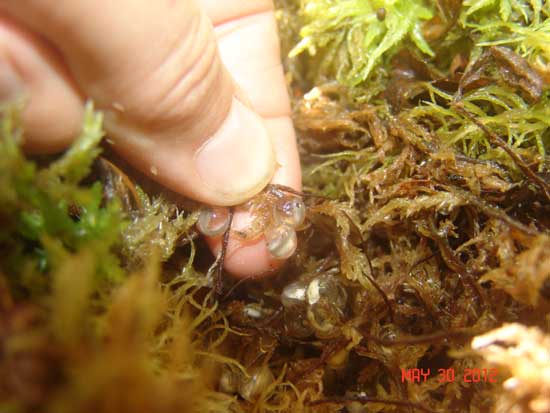
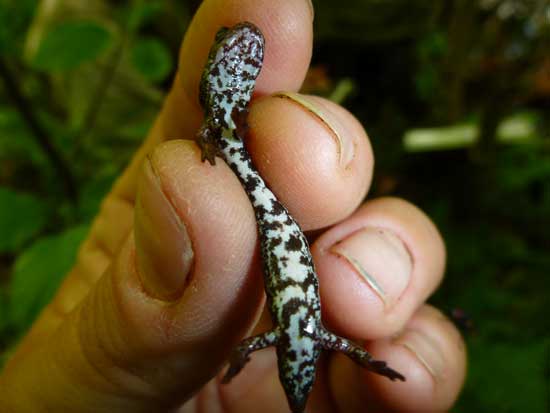
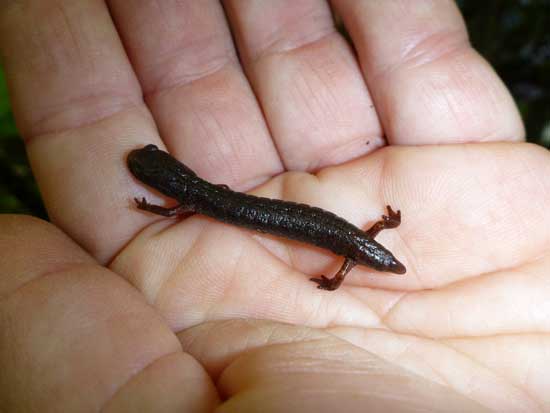
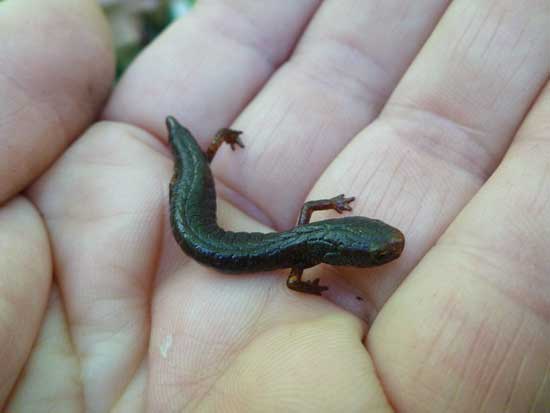


 Courtney Kerns gets acquainted with triangle moonwort. Can you see it? There is just one plant in the photo, along with one matricary moonwort.
Courtney Kerns gets acquainted with triangle moonwort. Can you see it? There is just one plant in the photo, along with one matricary moonwort.
 Jason Meyer of the St. Louis County Land Department discusses the significance of this hardwood forest with Bruce Carlson, Courtney Kerns, and Rebecca Holmstrom.
Jason Meyer of the St. Louis County Land Department discusses the significance of this hardwood forest with Bruce Carlson, Courtney Kerns, and Rebecca Holmstrom.












 Minnesota dwarf trout lily (Erythronium propullans). Photo by volunteer Don Kaddatz.
Minnesota dwarf trout lily (Erythronium propullans). Photo by volunteer Don Kaddatz. Derek Anderson works with a volunteer to flag and count flowering individuals at Nerstrand Big Woods State Park. Photo by volunteer Ron Taallerud.
Derek Anderson works with a volunteer to flag and count flowering individuals at Nerstrand Big Woods State Park. Photo by volunteer Ron Taallerud. Volunteers flag individual flowering plants. Photo Ron Taallerud.
Volunteers flag individual flowering plants. Photo Ron Taallerud.
